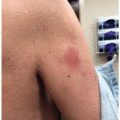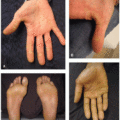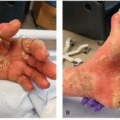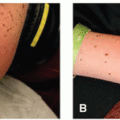Inflamed Actinic Keratoses
Emma H. Weiss
Caroline A. Nelson
Jonathan S. Leventhal
Inflammation of clinical and subclinical actinic keratoses is commonly seen with systemic administration of antimetabolites, such as 5-fluorouracil, capecitabine, taxanes, and other cytotoxic and targeted chemotherapeutic agents.1 Of note, it has been widely reported across many agents and classes; thus, lists of implicating drugs are generally not exhaustive. If the clinical pattern is consistent in a patient on cytotoxic therapy, this diagnosis is always considered plausible. It is hypothesized that the UV-induced cytological atypia and abnormal proportion of cells undergoing DNA synthesis make actinic keratoses more susceptible to chemotherapeutic damage.2
Typically, patients with pre-existing actinic damage develop eruptive photodistributed pink-red hyperkeratotic gritty papules several weeks after initiation of therapy (Figure 20.1). The upper back, anterior upper chest, and forearms are most commonly involved (Figure 20.2). Importantly, areas without sun damage (axillae, upper inner arms, buttocks, etc.) are spared (Figure 20.3). In patients with widespread actinic damage, looking for this pattern can help
distinguish from other inflammatory eruptions. Lesions can be mildly pruritic or asymptomatic. Inflammation typically resolves despite continued treatment or after cessation of chemotherapy. Biopsy may be considered to confirm the diagnosis and exclude other entities, such as photolichenoid eruptions, if inflammation or symptoms persist. Importantly, patients with inflamed actinic keratoses can be safely continued on anticancer therapies.1 Mid-potency topical corticosteroids provide symptomatic relief and hasten the resolution of the inflammatory process.
distinguish from other inflammatory eruptions. Lesions can be mildly pruritic or asymptomatic. Inflammation typically resolves despite continued treatment or after cessation of chemotherapy. Biopsy may be considered to confirm the diagnosis and exclude other entities, such as photolichenoid eruptions, if inflammation or symptoms persist. Importantly, patients with inflamed actinic keratoses can be safely continued on anticancer therapies.1 Mid-potency topical corticosteroids provide symptomatic relief and hasten the resolution of the inflammatory process.
Stay updated, free articles. Join our Telegram channel

Full access? Get Clinical Tree







